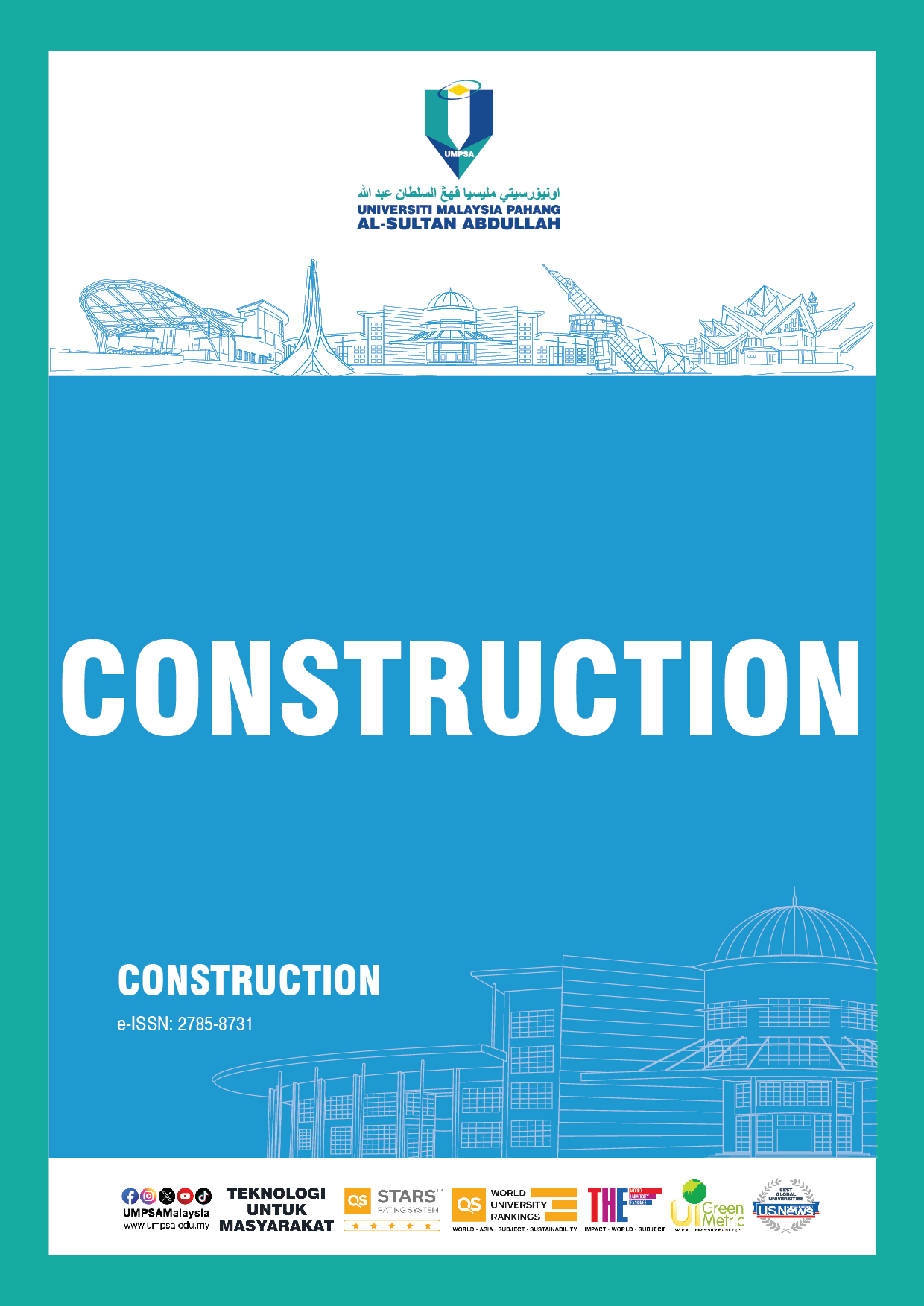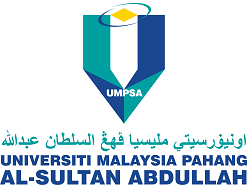Water Quality Evaluation of Tigris River by using Canadian and Horton Water Quality Index
DOI:
https://doi.org/10.15282/construction.v4i1.9748Keywords:
Tigris river, Water Quality Index, CCME, Horton’s WQIAbstract
Water quality index (WQI) is a simplified and explicable number calcuated from data on tested prameters in water. In this study, two methods for calculating water quality index (WQI) were used to assess the water quality of Tigris River using monthly data from 2011 to 2013. The data were collected at four different gauging stations. Two gauing stations are located on Tigris River at upstream in Mosul city while the other two downstream gauging stations are located on Tigris River at downstream in Al-Amarah city. The Canadian Council of Ministers of the Environment’s (CCME WQI) and Horton (Horton’s WQI) methods were applied to assess the water quality of Tigris River at the selected stations. The data used in the assessment included several parameters such as calcium (Ca), magnesium (Mg), sodium (Na), potassium (K), chloride (Cl), sulfate (SO4), bicarbonate (HCO3), nitrate (NO3), total dissolved solid (TDS), biochemical oxygen demand (BOD5) and electric conductivity (EC). According to the values of CCME WQI mehod, the quality of Tigris River in Mosul city was at a good level (the values of WQI were varied from 83 to 94) while it and falls under the marginal category in Al-Amarah city (the values were varied from varied from 52 to 59). However, the application of Horton’s WQI method showed that the quality of Tigris River in Mosul city was fluctuated from excellent to good (values of WQI varied from 24 to 80 per month) while it was poor in Al-Amarah city (values of WQI varied from 74 to 160 per month). In conclusion, the Horton’s WQI method was found more relastic when used to assess the water quality of Tigris River compared with CCME WQI method.
Downloads
References
M. R. Nurul-Ruhayu, Y. J. An and Y. Khairun, “Detection of river pollution using water quality index: a case study of tropical rivers in Penang Island, Malaysia,” Open Access Library Journal, vol. 2, no. 3, pp. 1-8, 2015.
Z. Z. Al-Janabi, A. R. Al-Kubaisi, and A. H. Al-Obaidy, “Assessment of water quality of Tigris River by using water quality index (CCME WQI),” Journal of Al-Nahrain University, vol. 15, no. 1, pp. 119-126, 2012.
N.O. Al-Musawi, and F. M. Al-Rubaie, “Prediction and assessment of water quality index using neural network model and GIS case study: Tigris River in Baghdad city,” Applied Research Journal, vol. 3, no. 11, pp. 343-353, 2017.
A. H. Al-Obaidy, Z. Z. Al-Janabi, and E. J. Shakir, “Assessment of water quality of Tigris River within Baghdad City,” Mesopotamia Environmental Journal, vol. 1, no. 3, pp. 90-98, 2015.
B. J. Al-Obaidy, “Application of water quality index and water suitability for drinking of the Euphrates river withinAl-Anbar Province, Iraq,” Journal of Engineering, vol. 19, no. 12, pp. 1619-1633, 2013.
T. Akter, F. T. Jhohura, F. Akter et al., “Water Quality Index for measuring drinking water quality in rural Bangladesh: a cross-sectional study,” Journal of Health, Population and Nutrition, vol. 35, no. 1, pp. 1-12, 2016.
L. P. Abbasi T and S. A. Abbasi, “Water Quality Indices,” Environmental Earth Sciences, vol. 71, no. 10, pp.4625-4628, 2014.
A. H. Al-Aboodi, S. A. Abbas, and H. T. Ibrahim, “Effect of Hartha and Najibia power plants on water quality indices of Shatt Al-Arab River, south of Iraq,” Applied Water Science, vol. 8, no. 2, pp. 1-10, 2018.
M. Al-Mukhtar, and F. J. Al-Yaseen, “Modeling water quality parameters using data-driven models, a case study Abu-Ziriq marsh in south of Iraq,” Hydrology, vol. 6, no. 1, pp. 24, 2019.
S. H. Ewaid, S. A. Abed, N. Al-Ansari et al., “Development and evaluation of a water quality index for the Iraqi rivers,” Hydrology, vol. 7, no. 3, p. 67, 2020.
S. H. Ewaid, “Water quality evaluation of Al-Gharraf river by two water quality indices,” Applied Water Science, vol. 7, no. 7, pp. 3759-3765, 2016.
D. A. Haridas and S. P. Antony, “Prediction of water quality index of an Indian river using arithmetic index and regression models,” Environmental Engineering and Management Journal, vol. 18, no. 9, pp. 2035-2044, 2019.
H. Y. Pak, C. J. Chuah, M. L. Tan, E. L. Yong and S. A. Snyder, “A framework for assessing the adequacy of Water Quality Index–quantifying parameter sensitivity and uncertainties in missing values distribution,” Science of The Total Environment, vol. 751, p.141982, 2021.
P. M. Ravikumar Aneesul Mehmood, and R. J. A. Somashekar, “Water quality index to determine the surface water quality of Sankey tank and Mallathahalli lake, Bangalore urban district, Karnataka, India,” Applied Water Science, vol. 3, no. 1, pp. 247-261, 2013.
N. H. Than, C. D. Ly, P. V. Tat and N. N. Thanh, “Application of a Neural Network Technique for Prediction of the Water Quality Index in the Dong Nai River, Vietnam,” Journal of Environmental Science and Engineering, vol. 5, pp. 363-370, 2016.
R. Al-Ani, A. Al Obaidy, and F. J. Hassan, “Multivariate analysis for evaluation the water quality of Tigris River within Baghdad City in Iraq,” Iraqi Journal of Agricultural Sciences, vol. 50, no. 1, pp. 331-342, 2019.
A. Chabuk et al., “Water quality assessment along Tigris River (Iraq) using water quality index (WQI) and GIS software,” Arabian Journal of Geosciences, vol. 13, no. 14, pp. 1-23, 2020.
S. H. Ewaid, S. A. Abed and S. A. Kadhum, “Predicting the Tigris River water quality within Baghdad, Iraq by using water quality index and regression analysis,” Environmental Technology & Innovation, vol. 11, pp. 390-398, 2018.
L. H. Alazawii, M. R. Nashaat, and F. S. Muftin, “Assessing the effects of Al-Rasheed electrical power plant on the quality of Tigris River, Southern of Baghdad by Canadian Water Quality Index (CCME WQI),” Iraqi Journal of Science, vol. 59, no. 3A, pp. 1162-1168, 2018.
I. E. Issa et al., “Expected future of water resources within Tigris–Euphrates rivers basin, Iraq,” Journal of Water Resource and Protection, vol. 6, no. 5, pp. 421-432, 2014.
H. J. Khadim and H. O. Oleiwi, “Assessment of Water Quality in Tigris River of Al-Kut City, Iraq by Using GIS,” in E3S Web of Conferences. EDP Sciences, vol. 318, p. 04001, 2021.
M. G. Uddin, S. Nash, and A. I. Olbert, “A review of water quality index models and their use for assessing surface water quality,” Ecological Indicators, vol. 122, p. 107218, 2021.
S. A. Hussein, A. A. Abdulla, and S. A. Abdulla, “An appraisal to lower reaches waters’ of Euphrates River by applying CCME Water quality index,” vol. 4, no. 2, 2015.
S. A. Alhashimi, and A. S. J. Mustafa, “Prediction of Water Quality Index for Euphrates River, Iraq,” International Journal for Environment and Water, vol. 1, no. 2, pp. 114-128, 2012.
S.M. Ahmed, A. A. Abedulwahab, R. T. Wahab, M. Najemaldin, and O. M. E. Taha, “Assessment of Lower Zab river water quality using both Canadian Water Quality Index Method and NSF Water Quality Index Method,” Engineering and Environmental Sciences, vol. 29, no. 2, pp. 155–171, 2020.
R. SH Suhaili and N. J. Nasser, “Water quality indices for Tigris River in Baghdad city,” Journal of Engineering, vol. 3, 14, pp. 2656-2668, 2008.
A. Ahsan, T. Ahmed, M. A. Uddin, M. Al-Mutiry, and A. Masria, “Evaluation of Water Quality Index (WQI) in and around Dhaka City using groundwater quality parameters,” Water (Switzerland), vol. 15, no. 14, p. 2666, 2023.
A. H. AbdUlameer and A. O. Al-Sulttani, “Evaluation of the Minimum Instream Flow: A Case Study of Shatt-Al Hillah River in Babylon Governorate,” International Journal of Design and Nature and Ecodynamics, vol. 18, no. 2, pp. 485–491, 2023.
Downloads
Published
Issue
Section
License
Copyright (c) 2024 The Author(s)

This work is licensed under a Creative Commons Attribution-NonCommercial 4.0 International License.




